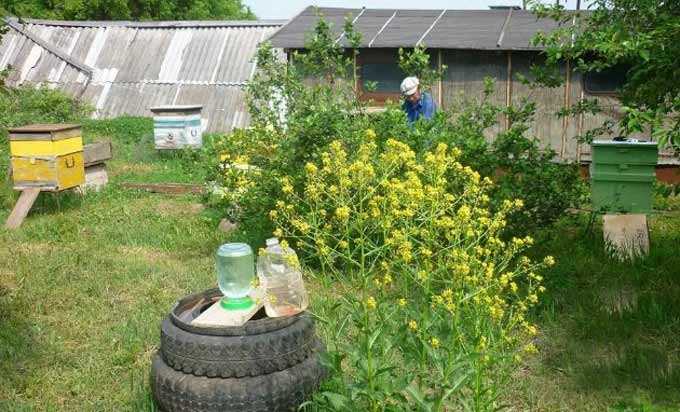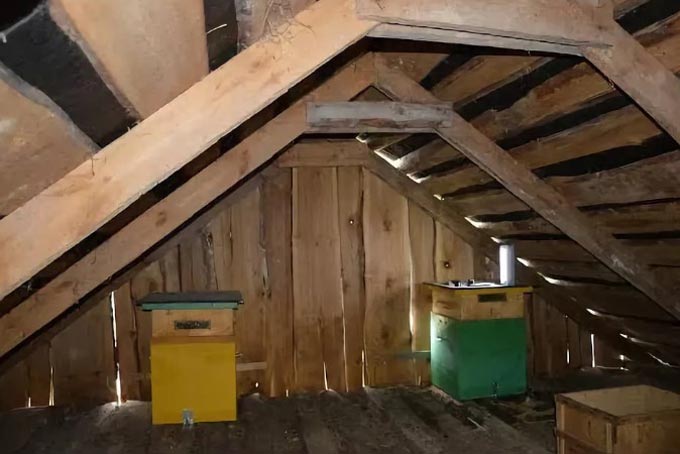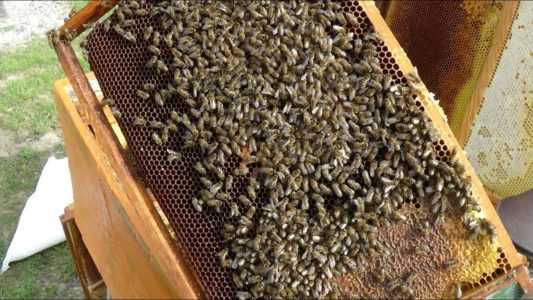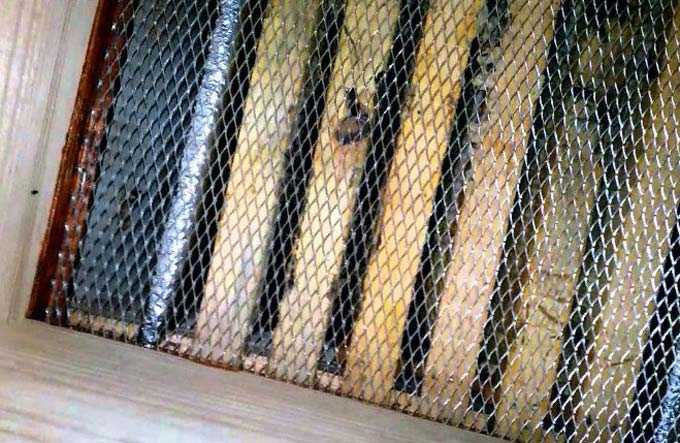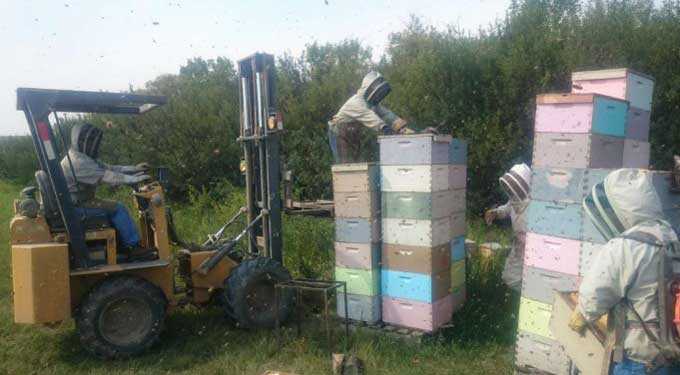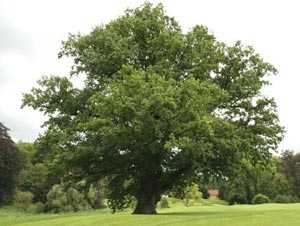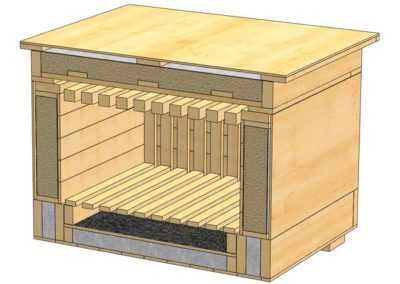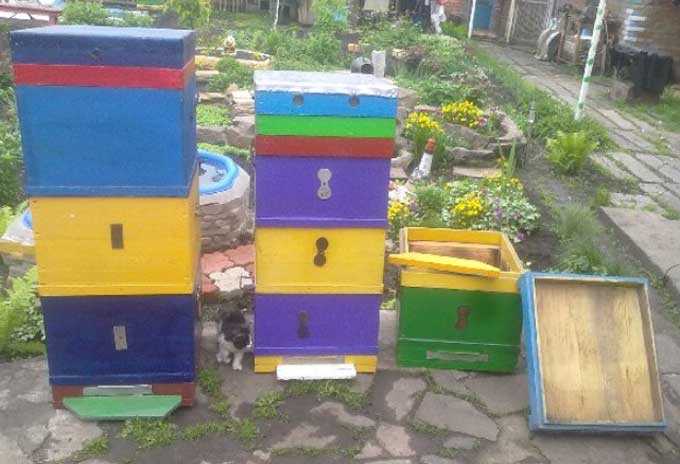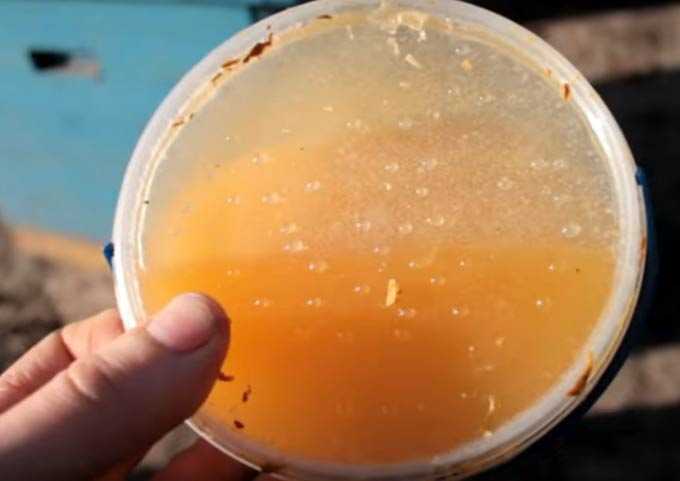An amateur apiary, which has not yet reached large volumes of honey production, can be placed on a personal or summer cottage without any problems. An apiary in the country is an ideal option for a novice beekeeper. Moreover, you can use different placement options: on a separate site (point) in the garden, in the attic of a cowshed or other agricultural structure, and even under the roof of a residential building.
The content of the article
- 1 What a beginner needs to know
- 1.1 Habitat
- 2 Village apiary
- 3 Attic beekeeping
- 3.1 Advantages of the method
- 3.2 Hive placement rules
- 3.3 Soundproofing and arrangement of the attic
- 3.4 Can I use a barn
- 3.5 Lighting and ventilation
What a beginner needs to know
Beekeeping is a serious business that must be approached with full responsibility. After all, bees can be aggressive towards domestic animals and humans. In theory, they are capable of attacking neighbors and harm their health. And in the presence of severe allergies, bee stings are fatal.
In practice, an apiary at home or in a summer cottage, garden plot is always a risk. Insects can be extremely aggressive among inept and greedy beekeepers. For example, inspection of hives in bad weather leads to a violent attack by bees on anyone who happens to be near the apiary.
It will be useful to familiarize yourself with the provisions of the federal law of the Russian Federation “On beekeeping”, which regulates the maintenance of bees. The purpose of this law is to regulate the relationship between beekeepers and closest neighbors.
It is assumed that compliance with all legislative norms will allow to peacefully resolve any conflict situations, even if the neighbors are strongly opposed to breeding bees near their home or plot.
Therefore, a novice beekeeper should consider three important points:
- the apiary and, accordingly, all bee colonies must be registered with local authorities;
- it is necessary to obtain a sanitary and veterinary passport for this farm;
- when organizing a beekeeping farm of any size, it must be borne in mind that the number of bee colonies may be limited in accordance with the charter of a particular dacha cooperative, horticultural association or partnership – you will have to familiarize yourself with these documents in advance.
You can read more about registering a backyard apiary in our separate article: On obtaining a sanitary and veterinary apiary passport
Habitat
So that beekeeping is not unprofitable, and the expenses are not in vain, the beginner will have to soberly assess all the plant resources of the area in which, according to the plan, the hives should be based.
Determining the forage base (honey balance) available in a particular area is a priority planning task! Indeed, without a sufficient number of melliferous plants, one cannot count on a good harvest of honey.
The table for determining the honey balance can be found in this article: Features of organizing an apiary from scratch – tips for beginners
It should be noted that a careful examination of the surroundings is quite an exciting experience. Because a person rarely thinks about what surrounds him. He simply does not know the plants growing nearby, their life cycle and useful properties.
From a beekeeping point of view, the following are beneficial in the environment:
- forests and fields;
- surrounding gardens with fruit trees;
- flower beds growing nearby, diligently cultivated by neighbors;
- flooded meadows and pastures for farm animals;
- forbs growing in abundance on the slopes of ditches and on other lands undeveloped by man;
- barrage landings and right-of-way of roads laid alongside.
The closer to large cities and towns, the poorer and more dangerous plant resources for bees. For example, honey collected from acacia, a cordon bordering a busy highway, can be hazardous to human health. And the nectar brought from the fields, actively treated with pesticides, leads to the death of the insects themselves.
Therefore, in suburban areas, it is important to pay attention to the environmental factor. Whether the brought honey will be marketable or not depends on the specific area. In difficult environmental conditions, bees will heal the surrounding flora by pollinating gardens and vegetable gardens. But making a profit from an apiary will be a big question.
The placement of hives should be reasonable, taking into account all the above-mentioned features of the forage base and ecology in a particular region. Below are examples of placement:
- a) in correct rows;
- b) staggered;
- c) in a group checkerboard pattern.
Village apiary
With an apiary in the village, as a rule, things are easier. Especially if the countryside is located far from cities, and the settlement has few inhabitants. In this case, the beekeeper is given a certain freedom of action.
It may turn out that the site is separated from the nearest neighbors by hundreds or even tens of meters, and ecologically clean meadows, fields and forests are spread around. In such favorable conditions, it remains only to worry about the correct protection of the hives from the prevailing winds and the sultry summer sun.
When installing bee houses, avoid open areas without vegetation in the form of trees or tall shrubs. As well as damp areas near water bodies, where the soil and air are saturated with moisture.
The optimal place for placement is dry gentle slopes in the south and southeast of the site. Here rain and melt water quickly leaves the bee spot – it dries well even in early spring and late autumn.
You can read more about the correct placement of a home apiary within the boundaries of any settlement here: How to properly organize an apiary from scratch
Attic beekeeping
Placing hives under the roof of the building allows bees to fly out of the houses and lay an air route in a safe area for humans. If the hives are installed on the ground, it is necessary to enclose them with a high fence. Only in this case insects will not accidentally sting passers-by or animals.
The attic placement of the apiary also solves the problem with the lack of space. There is no need to install houses in the garden or purchase (rent) a separate plot for this purpose.
Pavilion content is a common practice in European countries. With a high population density and the absence (insufficient) of sites for the installation of bee houses, this is the most practical option for breeding honey bees.
Small 12-frame Dadant-Blatt hives with opening back walls are suitable for such content. Or the usual Langstroth-Root multi-hull structures, which allow the houses to be installed in several tiers.
Advantages of the method
Attic (pavilion) maintenance has a number of advantages:
- the productivity of the apiary increases;
- the content is safe for people and animals;
- dependence on bad weather conditions and time of day is excluded – you can work with bees at any suitable time;
- conditions of detention are improved – there are no sudden temperature changes, good ventilation is provided;
- the durability of the hives increases – structures with thin walls and even plywood can be used;
- during wintering, it becomes possible to artificially regulate the air temperature by means of electric heaters.
All of the above advantages are characteristic of attics and pavilions with a floor, walls and ceiling thickness of at least 100-120 mm or provided with insulation appropriate in terms of thermal insulation properties.
Hive placement rules
To exclude insect aggression against people, an arrival area is provided that is inaccessible to outsiders. It is about 4-5 meters in front of the building where the bees live.
A green fence is planted around the perimeter of the landing area. Part of the zone can be limited by the adjacent wall of the house or by a blank fence.
Special attention is paid to insulation. A layer impermeable to steam, for example roofing felt, is laid only on the inner side of the walls of the pavilion (attic space). Outside, glassine, building cardboard, plaster are used – materials that allow water vapor to pass through well. And the best insulation in this case is a mixture of sawdust and 5% lime (there is a bucket of lime for 20 sawdust buckets). It is poured into a frame structure or on the floor.
The apiary under the roof of the house can accommodate up to 10 bee colonies (area from 6 to 10 square meters). In this case, it is required to additionally equip an uninsulated utility room for storing beekeeping equipment, honeycombs and frames.
The holes can have an exit along one wall (pediment). However, the maintenance of ten or more bee colonies requires the equipment of entrance slots in two walls at once, preferably facing east and west. In this case, the constructed slots are edged with 20 x 25 mm slats. This facilitates the coincidence of the slots with the hives attached to the wall.
Soundproofing and arrangement of the attic
The apiary in the attic of an inhabited house should be isolated from sound and vibration.
For this, the attic floor is lined with a mixture of sawdust and lime. The insulation layer should be at least 15-20 centimeters. A shield is installed on top, mounted from wooden boards with a thickness of at least 5 millimeters. This planking must not be in contact with the walls or the main floor of the attic. Insulated linoleum can be spread on top of the shield, and hives can be placed on it.
Bees especially need rest during the wintering period. A board made of boards and a thick layer of insulation will block all sounds coming into the attic from the house. As practice shows, even children’s screams and running around do not cause much concern in insects.
For natural smoke extraction when working with a smoke, a window or transom must be equipped in the attic. It is preferable to arrange ventilation near the bee houses – on the wall, which adjoins the entrances.
Can I use a barn
The apiary in the attic of a cowshed or chicken coop is not equipped for obvious reasons. The farm or poultry yard does not meet the sanitary standards for keeping bees.
According to veterinary rules, hives are placed no closer than a kilometer from any livestock buildings. This is especially true for industrial buildings – poultry farms, farms. There is a danger of spreading the causative agents of nosematosis and other dangerous bee infections.
Another important point is the attitude of the bees themselves to pungent odors. There were cases when insects attacked neighboring chickens, goats, and cows. There is an opinion that such aggression is caused precisely by the characteristic agricultural smell.
But there is also another practice. Some beekeepers keep hives above the henhouse or barn for many years in a row without any harm to both the bees and the aforementioned agricultural animals. What to do in a particular case – to use a cowshed or chicken coop as a habitat for bee colonies – is decided by the owner himself, acting at his own peril and risk.
Lighting and ventilation
Combined electric lighting from incandescent lamps with shades and daylight is installed in the attic. When opening the hives, insects always rush to the light bulbs. If there are too many of them accumulated in the attic, it is necessary to turn off the lighting for 2-3 minutes and open the ventilation window (transom) wide open.
During work, it is recommended to turn on the light or open the windows located near the open bee house. Moreover, the lamps are mounted above the windows, which makes it easier for insects to fly out into the street.
3-4 multi-body hives should be equipped with two fluorescent lamps and one ventilation window, 1 x 000 mm in size.
Attic beekeeping is, first of all, convenience and comfortable life for honey bees. As beekeeping practice suggests, they can be settled in any suitable attic, where it is warm, clean and dry: in a garden house, above a bathhouse, a shed, outbuildings. The only drawback of such content is the relatively small usable area available to the owner. Only an amateur apiary, limited by the number of hives, will be able to maintain in this way.
